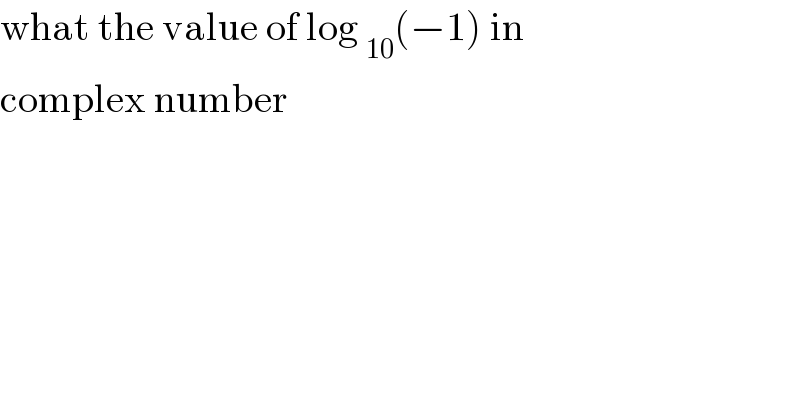
Question and Answers Forum
Question Number 116725 by bemath last updated on 06/Oct/20

Commented by bemath last updated on 06/Oct/20

Commented by MJS_new last updated on 06/Oct/20
![usually we take the principal value z=re^(iθ) with r∈R^+ and −π≤θ<π [ ] ⇒ principal value of ln z =ln r +iθ and log_z_2 z_1 =((ln z_1 )/(ln z_2 ))=((ln r_1 e^(iθ_1 ) )/(ln r_2 e^(iθ_2 ) ))=((ln r_1 +iθ_1 )/(ln r_2 +iθ_2 ))= =((θ_1 θ_2 +ln r_1 ln r_2 )/(ln^2 r_2 +θ_2 ^2 ))+i((θ_1 ln r_2 −θ_2 ln r_1 )/(ln^2 r_2 +θ_2 ^2 )) with r_1 , r_2 >0](Q116748.png)
Commented by MJS_new last updated on 06/Oct/20

Answered by MJS_new last updated on 06/Oct/20

Commented by bemath last updated on 06/Oct/20

Commented by bemath last updated on 06/Oct/20

Answered by TANMAY PANACEA last updated on 06/Oct/20
![trying Log(a+ib) a=rcosθ b=rsinθ Log(re^(iθ) )=Log(re^(i(2kπ+θ)) )=logr+i(2kπ+θ) Log(a+ib)=log((√(a^2 +b^2 )) )+i{2kπ+tan^(−1) ((b/a))} Log(a+ib)=(1/2)log(a^2 +b^2 )+i(2kπ+tan^(−1) ((b/a))) log_(10) p×x=log_e p ((logp)/(log10))×x=((logp)/(loge))→x=log_e 10 log_(10) (−1)=log_e (−1)×log_(10) e log_(10) (−1) =log_e (−1)×log_(10) e =[(1/2)ln(1+0^2 )+i(2kπ+tan^(−1) (((−1)/0))]log_(10) e =[0+i(2kπ−(π/2))]log_(10) e](Q116731.png)
Commented by bemath last updated on 06/Oct/20

Commented by Rio Michael last updated on 06/Oct/20

Commented by Dwaipayan Shikari last updated on 06/Oct/20

Commented by bemath last updated on 06/Oct/20

Answered by Rio Michael last updated on 06/Oct/20

Answered by Dwaipayan Shikari last updated on 06/Oct/20

Commented by Dwaipayan Shikari last updated on 06/Oct/20

